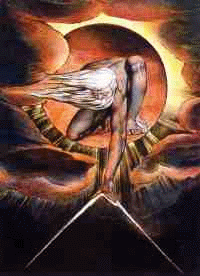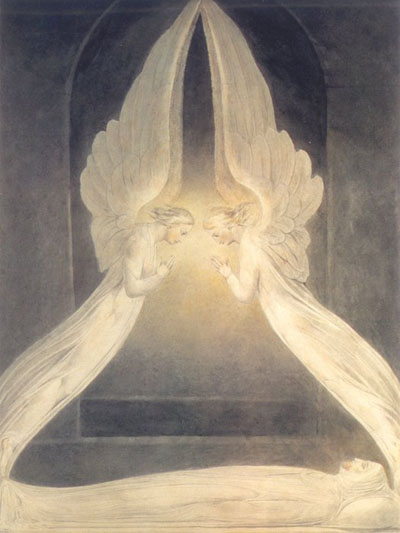 William Blake (1757-1827) was a poet, painter, engraver, mystic, and progressive in the tradition of Plato, Jesus, Rumi, and St. Francis. He was an omnivorous reader of the classics and was for a time a close friend of Thomas Taylor, the first translator into English of Plato and Plotinus. Taylor also published many translations of and commentaries on the major works of the Neo-Platonic, Orphic and Bacchic Mysteries.
William Blake (1757-1827) was a poet, painter, engraver, mystic, and progressive in the tradition of Plato, Jesus, Rumi, and St. Francis. He was an omnivorous reader of the classics and was for a time a close friend of Thomas Taylor, the first translator into English of Plato and Plotinus. Taylor also published many translations of and commentaries on the major works of the Neo-Platonic, Orphic and Bacchic Mysteries. Born in London, Blake lived almost his entire life there. As the second son of a working-class hosier he was never able to go to school. Instead, at the age of fourteen he was apprenticed to an engraver and for the remainder of his life it was through this craft that he earned a somewhat precarious livelihood.
His deep mystical intuition and his skill and genius as an artist and poet went almost unrecognized during his lifetime. He was able to sell very little of his own artistic output, and his letters which we have are primarily thank you notes to his patrons.
|
"William Blake is one of the great mystics of the world; and he is by far the greatest and most profound who has spoken in English. Like Henry More and Wordsworth, he lived in a world of glory, of spirit and of vision, which, for him, was the only real world. At the age of four he saw God looking in at the window, and from that time until he welcomed the approach of death by singing songs of joy which made the rafters ring, he lived in an atmosphere of divine illumination." |
When he was very young, Blake began to experience spiritual visions. When he was nine he saw "a tree filled with angels, bright angelic wings bespangling every bough like stars." These mystical visions and his spiritual inspiration remained with him for the rest of his life.
 In his mid-40s Blake lived for three years in a small cottage at Felpham on the Sussex coast where he saw angels descending on a ladder from heaven to his cottage. It was also at this time that he often saw fairies and once experienced what he understood to be a fairy’s funeral.
In his mid-40s Blake lived for three years in a small cottage at Felpham on the Sussex coast where he saw angels descending on a ladder from heaven to his cottage. It was also at this time that he often saw fairies and once experienced what he understood to be a fairy’s funeral.According to Blake, most of his work as a writer and artist was done under the direct inspiration of spiritual guides. In the introduction to his book on Milton, he explains:
"I have written this poem from immediate dictation, twelve or sometimes twenty lines at a time, without pre-meditation and even against my will. The time it has taken in writing was thus rendered non-existent, and an immense poem exists which seems to be the labour of a long life, all produced without labour or study."
Everything Blake created--his poems, his engravings, his illuminated books--were for the purpose of revealing to people the Higher Reality.
"I rest not from my great task!
To open the Eternal Worlds, to open the immortal Eyes
Of Man inwards into the Worlds of Thought, into Eternity."
. . .
Blake followed in the artistic tradition of what is called illuminated art or

lluminated

anuscripts

Illuminated art refers to the adornment of written or printed text or design with graphics, colors, gold, or silver. The original form of the verb "to illuminate" was "enlumine" and medieval craftsmen who practiced the art were called "enlumineurs."
We have illuminated manuscripts from before the Christian era, for example, the ancient Egyptian Book of the Dead and the Greek Iliad.
To the right is the work of Guvart des Moulins in his Bible Historiale - 1402 - From the Life of Solomon.

We have illuminated manuscripts from before the Christian era, for example, the ancient Egyptian Book of the Dead and the Greek Iliad.
To the right is the work of Guvart des Moulins in his Bible Historiale - 1402 - From the Life of Solomon.

|
"Blake was many things. He was Platonist and Neoplatonist, Alchemist and Paracelsian. He knew the Hermetic literature and had read Swedenborg. He was so many things that it is better simply to say that he was their synthesis in an artist. All his life he made runes so rare in form and invitation that one's love affair with William Blake may begin in childhood and last to the end of life, with ever growing appreciation of his work." |
In the modern era, the illuminated manuscripts of William Blake stand out as the creative orchestration of text and imagery. He wanted to open our eyes to the world of spirit as it mingled with the mundane world.
Part of what excited Miss Raine as she completed the research for her book was to discover the Perennialist roots of Blake's work. I wander thro' each charter'd street,
"If the doors of perception are cleansed every thing would appear to man as it is, infinite.
For man has closed himself up, till he sees all things thro’ narrow chinks of his cavern."


 "Blake's greatest disciple . . . W. B. Yeats, announcing the end of a cycle and the advent of the 'rough beast,' was but following Blake. 'The rise of soul against intellect, now beginning in the world,' announced by Yeats, has brought with it a return to the excluded knowledge -- Neo-Platonism, alchemy, astrology, Cabbala -- besides the more recent studies of Indian metaphysics, comparative mythology, psychical research, and the psychology of the unconscious. All these and other related fields of knowledge, once dismissed piecemeal, are now seen to belong to a coherent way of understanding and exploring what we choose to call 'reality.'"
"Blake's greatest disciple . . . W. B. Yeats, announcing the end of a cycle and the advent of the 'rough beast,' was but following Blake. 'The rise of soul against intellect, now beginning in the world,' announced by Yeats, has brought with it a return to the excluded knowledge -- Neo-Platonism, alchemy, astrology, Cabbala -- besides the more recent studies of Indian metaphysics, comparative mythology, psychical research, and the psychology of the unconscious. All these and other related fields of knowledge, once dismissed piecemeal, are now seen to belong to a coherent way of understanding and exploring what we choose to call 'reality.'"
"I can only report, from my own explorations, that this Lost Atlantis is a land of treasures and marvels. Blake's 'golden string' leads not only through his own labyrinth, but is the clue leading to so much more. Neo-Platonism, with its mythology and symbolism, is indeed the local European idiom (as Coomaraswamy would say) of a universal and unanimous tradition. Those sources from which Blake drew his knowledge -- and in our own century, Jung, Yeats, and increasing numbers of their followers -- are learning of the imagination itself. The excluded knowledge of the last two or three centuries seems likely to become the sacred scriptures of a New Age for which spirit, not matter, is again the primary reality."
Blake's masterful poem "The Tyger" seems to epitomize his recurring theme that "He who sees the Infinite in all things sees God."
"Tyger! Tyger! burning bright
In the forests of the night,
What immortal hand or eye
Could frame they fearful symmetry?
In what distant deeps or skies
Burnt the fire of thine eyes!
On what wings dare he aspire?
What the hand, dare seize the fire?
And what shoulder, and what art,
Could twist the sinews of thy heart?
And when thy heart began to beat,
What dread hand? and what dread feet?
What the Hammer? what the chain,
In what furnace was thy brain?
What the anvil? what dread grasp,
Dare its deadly terrors clasp?
When the stars threw down their spears
And water'd heaven with their tears;
Did he smile his work to see?
Did he who made the Lamb make thee?
Tyger, Tyger burning bright,
In the forests of the night;
What immortal hand or eye,
Dare frame thy fearful symmetry?"

William Blake was a modern alchemical mystic. Through his art, poetry, and writing he was able to distill sentience (mercury) within physical existence to a "point" where consciousness re-identifies with the golden light (Sun) of the soul.
"'London' is spoken by a poet-prophet wandering through the imperial city, stunned by what he sees and feels. Human misery is everywhere around him: 'I ... mark in every face I meet / Marks of weakness, marks of woe.' There are a number of sources for this misery, but maybe the main one—or at least the one Blake cites first—is the locking down of human consciousness. The people Blake sees are miserable in large part because their minds are radically restricted by oppressive ways of thinking. They are the victims of 'mind-forg'd manacles.' That is, they are imprisoned by their own mental limits and by the limits imposed upon them by others."
As we saw in an earlier essay, to realize one's complete human essence (Arete), a person must not only achieve excellence in the arts, in the world of politics or finance, in sports or entertainment, he must also develop genuine concern for human well-being and work toward the full realization of a just and egalitarian society.
In his poem London, Blake epitomizes his progressive sensibility.
London
Near where the
charter'd Thames does flow,
And mark in every face I
meet
Marks of weakness, marks of woe.
In every cry
of every Man.
In every Infant's cry of fear,
In every
voice, in every ban,
The mind-forg'd manacles I
hear.
How the Chimney-sweepers cry
Every black'ning
Church appalls;
And the hapless Soldier's sigh
Runs in
blood down Palace walls.
But most thro' midnight streets I
hear
How the youthful Harlot's curse
Blasts the new born
Infant's tear
And blights with plagues the Marriage hearse.
